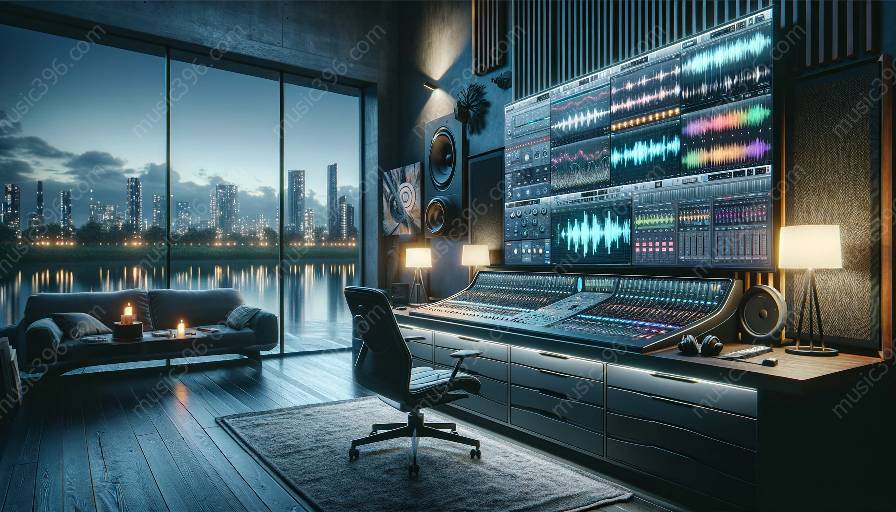Post-production in film and television plays a critical role in refining the visual and auditory elements to create a captivating final product. When it comes to sound engineering, audio software applications have become an integral part of the process, providing filmmakers and sound engineers with powerful tools to enhance and optimize the audio components of their projects.
In this comprehensive exploration, we will delve into the ways audio software enhances the post-production process in film and television. We'll examine the intersection of audio software applications and sound engineering, and how these tools contribute to creating immersive and memorable audio experiences for audiences.
The Role of Audio Software in Post-Production
Audio software applications offer a wide range of functionalities that are essential in the post-production process. These tools enable sound engineers and filmmakers to manipulate, refine, and enhance audio elements, ensuring that the final product meets the highest standards of quality and creativity. Some of the key ways in which audio software enhances post-production include:
- Editing and Mixing: Audio software provides powerful editing and mixing capabilities, allowing sound engineers to fine-tune each audio element and create a seamless blend of sounds. This process is crucial in achieving the desired audio atmosphere and maintaining coherence throughout the production.
- Sound Effects and Foley: Audio software applications offer extensive libraries of sound effects and Foley, enabling creators to enhance the sonic landscape of their projects. With the ability to manipulate and customize these elements, filmmakers can add depth and realism to their audio compositions.
- Dialogue Enhancement: Clear and intelligible dialogue is paramount in film and television, and audio software provides tools for enhancing dialogue clarity, removing background noise, and balancing speech levels to ensure optimal audience comprehension.
- Audio Restoration: In cases where the original audio recordings are flawed, audio software can be used for restoration, repair, and enhancement, salvaging unusable recordings and revitalizing audio quality.
Integration of Audio Software with Visual Elements
One of the unique aspects of audio software in post-production is its integration with visual elements. In film and television, sound engineering goes hand in hand with visual storytelling, and audio software applications play a vital role in synchronizing audio with the on-screen action. This integration involves:
- Syncing Sound with Visuals: Audio software allows for precise synchronization of sound effects, music, and dialogue with visual cues, ensuring that the auditory and visual elements are harmoniously aligned to create a cohesive and immersive experience for the audience.
- Immersive Sound Design: With the advancement of audio software technology, sound engineers can now create immersive soundscapes that complement and enhance the visual narrative. This includes spatial audio design, 3D audio processing, and surround sound mixing, all of which contribute to a more immersive viewing experience.
- Remote Collaboration: Audio software applications often feature collaborative tools that enable multiple team members to work on audio elements simultaneously, regardless of their geographical locations. This fosters seamless collaboration and accelerates the post-production process.
- Automation and Batch Processing: Audio software offers automation and batch processing capabilities, allowing for repetitive tasks to be performed quickly and efficiently, freeing up time for sound engineers to focus on more creative and strategic aspects of the post-production process.
- Artificial Intelligence and Machine Learning: As AI and machine learning technologies continue to advance, they are being integrated into audio software applications, offering features such as automated audio analysis, intelligent noise reduction, and adaptive audio processing.
- Immersive Audio Formats: The demand for immersive audio experiences is growing, and audio software is adapting to support formats such as Dolby Atmos, DTS:X, and Auro-3D, enabling sound engineers to create spatially immersive soundscapes that envelop the audience.
- Interactive Audio for VR and AR: With the rise of virtual and augmented reality experiences, audio software is evolving to support interactive audio design, spatial audio rendering, and real-time audio processing, catering to the demands of these emerging mediums.
Collaborative Workflow and Efficiency
Another significant benefit of audio software in post-production is its ability to streamline collaborative workflows and enhance efficiency. These benefits include:
Emerging Trends in Audio Software and Sound Engineering
The landscape of audio software and sound engineering is continually evolving, driven by technological advancements and creative innovations. Some of the emerging trends that are shaping the future of audio post-production in film and television include:
Conclusion
Audio software plays a pivotal role in enhancing the post-production process in film and television, offering a myriad of tools and capabilities that empower sound engineers and filmmakers to create immersive, high-quality audio experiences for audiences. As technology continues to evolve, the intersection of audio software applications and sound engineering will undoubtedly drive further innovation in the way audio is crafted and integrated into visual storytelling.


























